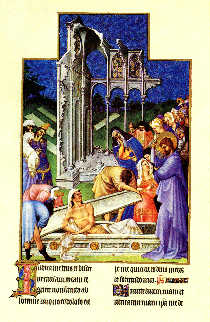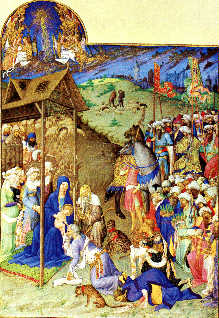


-
Its history
MEHUN (Magdunum in 1012), this term of Celtic origin Mag meaning Fields or the idea of Polished Greeks, Dunum translated in the beginning the idea of fence and height. Among testimonys of the oldest human presence collected in Mehun, appears in particular a polished stone axe dating from the age of bronze. Highest antiquity appears with the dolmen located at one kilometer of Mehun with Chardoille.
The castle of Mehun-sur-Yevre was built in 1366-1386 by the duke Jean de Berry (1340- June 15, 1416). It brought all its ardour and its enthusiasm with the construction of the castle and did of it “one of the most beautiful houses of the world”. It will lèguera it with its nephew the King of Bourges: Charles VII.
Charles VII will receive there Jeanne d' Arc in 2 times (in 1429 and 1430). His/her son, the future Louis XI, will plot already against his father in these places.
In XVème century the future Charles VII entered in possession of Mehun on Yevre; the proclamation of the king Charles VII was done in the vault of the castle on October 30, 1422. It was hardly 19 years old.
It is Jeanne d' Arc who led Charles VII to Rheims to make it crown, and to become thus the only legitimate king of all French in 1429. Mehun on Yevre was then the political capital of the capacity and it is there that Charles VII joined together his council. Another woman was to play, in the life of Charles VII and the history of the city, an indisputable role: it is about beautiful, charming and mysterious Agnès Sorel. Of a bright beauty, endowed with a great charm, it was its mistress and gave him four girls.
- "Barberin Door" opening towards the west (it does not exist today any more),
- "Door of the clock" or "Carries from Bourges" opening towards the east.
- the prior of “Monstereul-Boney” Guillaume de Jouay,
- et Jean de Targé, écuyer
- Lusignan,
- Poitiers,
- XIème century for the chorus and the whole of the nave,
- XIIème century for the two last spans of the nave and the porch-bell-tower,
- The vault, southern side, mark XVème century.
Charles VII will make carry out in Mehun, of important work of restoration during years 1446, 1447 and 1456.
On Wednesday July 22, 1461, Charles VII died in his castle of Mehun on Yevre, at the 58 years age. With its death ends the great period of the history of Mehun-sur-Yevre.
Several kings de France followed one another the castle then, but none them will make its favorite residence of it. XVIIème and XVIIIème centuries only appear not very important in the history of Mehun, the political life being done in Paris and Versailles.
At this time, there are two doors called:
The latter was restored. It is surmounted by a belfry from where a continuous clock to sound the hours.


Keep of the castle transformed into museum and carries clock
Jean de France, duke of Berry (1340-1416)
Jean de France, duke of Berry, count de Poitou Third wire of Jean the Good and Good of Luxembourg. It is made count apanagist of Poitou in April 1356.
On June 8, it is promoted lieutenant of the king “in all the countries from on this side the river of the Loire and by all Languedoc”. The fifteen year old teenager must, urgently, like his two elder brothers (Louis of Anjou and Philippe the Bold one), to assume heavy responsibilities in front of the English danger represented at this time by the rides and plunderings to which Prince Noir delivers itself, heir to the throne of England.
In September, at the end of the battle of Nouaillé-Maupertuis, king Jean the Good, prince Jean de France and his two brothers are taken along to the shelter with Chauvigny. Chauvigny, from where the Duke of Berry will not return, with Of Guesclin and as a winner this time, which on August 7, 1372 (Public records, J 187 A n° 4).
Pendant la captivité du roi Jean le Bon en Angleterre et les années troublées de la régence du dauphin Charles (futur Charles V), le prince Jean de Berry n'est évidemment pas en possession de son apanage du Poitou, occupé en partie par l'ennemi. D'ailleurs, entre le 3 avril et le 24 octobre 1360, la conférence de Longjumeau puis les traités de Brétigny et de Calais n'arrangent en rien son sort, car il figure au nombre des quarante-et-un princes et hauts barons emmenés en otages à Londres. Les provinces atlantiques au sud de la Loire sont alors abandonnées aux Anglais.
During the captivity of king Jean the Good in England and the disturbed years of the regency of the dolphin Charles (future Charles V), prince Jean de Berry is obviously not in possession of his prerogative of Poitou, partly occupied by the enemy. Moreover, between on April 3 and on October 24, 1360, the conference of Longjumeau then the treaties of Brétigny and Calais do not arrange of anything its fate, because it appears in the number of the forty and one princes and high barons taken along as hostages to London. The Atlantic Provinces in the south of the Loire are then abandoned to the English.
Money lack to recruit and equip with the more troops, Jean de Berry resorts to average obliques to encourage in the population resistance to the English and to negotiate alliances and tenders in Poitou. Thus, on July 13, 1370, we see two discrete emissaries:


It can thus arrive to Poitiers only on March 20. As of the 23, it comes in Montreuil. And undoubtedly it made often stage there, when it went one to the other of its favorite residences poitevines :
The duke of Berry never played a part of foreground in the political history of XIVe and the beginning of the next century, and this in spite of the important responsibilities of which it was sometimes invested by his elder brother and his nephew Charles VI in the government of the kingdom.
This large refined and got excited lord of luxury, like all the princes of the line of Valois, seems to have had of another passion only to embellish his various residences, the hotel of Nesles in Paris, and the castle of Mehun-sur-Yevre as Berry in particular, and there to pile up, on the model of Charles V in Louvre and in Vincennes, the most beautiful collections artistic of time.
Three detailed inventories, drawn up between 1403 and its death in 1416, make it possible to have an idea of the incredible richness of these collections where were côtoyaient tapestries, reliquaries of goldsmithery and ivory, precious stones and manuscripts invaluable. Only a hundred of the latter survived the destruction. One finds in the inventories and the rare wrecks of the ducal accountancy the name of some of the largest artists of the time: thus the sculptor Andre Beauneveu, who, recruited in 1385, took part in the building site of Mehun-sur-Yevre and illustrated the psautier of his patron of twenty-four superb greyness making alternate twelve figures of prophets and the apostles; or the Jean illuminators the Black and Jacquemart de Hesdin which collaborate in the Small Hours (BNF, Lat 18014), and whose second ensured the direction of the team in charge of painted decoration of the Great Hours, completed in 1409.



The Romance church
Notre-Dame the old collegial one of Mehun-sur-Yevre was founded before 1069. The arched chorus, curiously built on a plan out of horseshoe, is surrounded by narrow arcades and is girdled of a déambulatoire with radiating chapels. It is a rare party as Berry.
The church evokes in its imposing mass Romance constructions of XIème and XIIème centuries:


Notre Dame church
The restoration of the outside of the church, carried out in 1974 by "Beautiful Arts", gave again with the bedside all its beauty and its originality.
When the church was increased in XIIème century, one would then have built the underpass allowing to go towards the castle.
Penetrating in the church by the large curved door of the frontage, one is struck by the somewhat cold simplicity of the nave. One can still see there the table of Grandin (1886) which represents Jeanne devoting her sword to Notre Dame. A statue located on the pilaster of entry of the double vault of the déambulatoire also points out the memory of Jeanne d' Arc.
Jean Boucher (1568-1633), artist berrichon, left in the church of Mehun a religious table expressing "the Martyrdom". It is one of the best compositions of this painter. He “is classified” and was restored recently by the administration of Beautiful Arts.
Under the table of Jean Boucher an imposing wrought iron lectern of the XVIIIème century, “classified as is”. Towards the bottom of the church, on the same wall, it is necessary to admire a cupboard with stone relics, whose door out of wooden is carved. What it is particularly necessary to admire in the nave, they are the fourteen stations of the modern Way of Cross; original and remarkable creation of Andre Rosay, ceramist on La Borne.
previous page ... next page ...
Copyright © Nicolas's Web Site
designed by Templatesbox